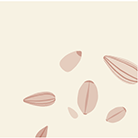All about wheat


Wheat was one of the first cereal crops cultivated by man. But in fact, the word wheat refers to several types of cereal. The two main types are soft wheat and durum wheat. The most common variety on the market, soft wheat is mostly used in milling. It is used to make flour, bread, viennoiseries, biscuits, etc. You need durum wheat, however, to produce semolina or pasta.
The history of wheat
The first traces of "wild wheat" date back approximately 15,000 years. Wheat was originally eaten raw, then toasted, or as gruel. During the Neolithic era (6,000 years BC), it was cultivated in the "fertile crescent", in what is now known as the Middle East. Mixed with water and cooked on hot stones, dry flatbread was first leaved by the Egyptians, who would add water from the Nile, which was rich in the natural ferments contained in yeast. From its original birthplace, the culture of wheat then extended to Central Asia and Africa. But 3,000 years would pass until it reached Europe!

Primitive wheat varieties had hulled seeds, which means they were covered in a membrane that could only be removed by winnowing and husking. But the grains were small, with limited nutritious reserves, and above all they contained no gluten, so the flour was not suitable for breadmaking. A long period of artificial selection was needed to produce harvestable wheat that would give flour suitable for breadmaking.
How is wheat sown and when is it harvested, in which season?

Wheat is sown in October. The stems that emerge during the winter start to elongate in early spring, and the ears emerge from their sheaths. After flowering and fertilisation, the grains swell. Wheat reaches maturity in July/August: that's harvest time…
The expert's perspective
"We need to make sure the plant gets enough food and is protected right up until harvest time." says José Collet, VIVESCIA FAE (Field Agronomy Expert) manager. "We just hope that no extreme weather events occur just before the harvest! Obviously, some times of year are more critical than others. Between April and June, it's the booting and then the grains fill out. For winter wheat, we need to be particularly vigilant of insects (plant hoppers, aphids, etc.), which can spread disease."
To know more




